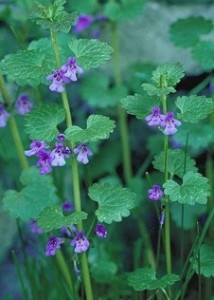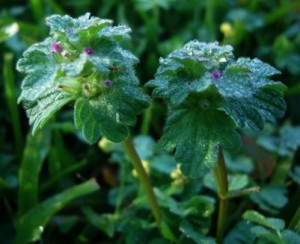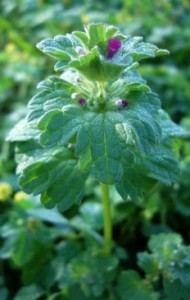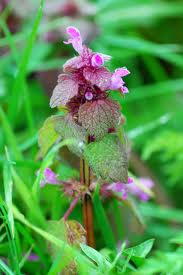Henbit: Springtime Salad Green and More
It was a zig and a zag for me. I heard the name as an edible for many years and saw the plant often but never put the two together until one spring I was picking chickweed and saw this plant yet again and decided to look it up then give it a try. Now it is one of those great little edibles of spring.
The henbit is a member of the mint family. If you remember from my first blog and my second video all mints that smell like a mint and look like a mint are edible, but they must do both. There are a lot of mints that do not smell minty, some of them are edible and some of them are not. In fact, some of the mints can make you ill. Henbit does not smell minty, but it is an edible mint. By they way, there are no poisonous look alikes. As for toxicity, we’re safe but it has causes “staggers” in sheep, horses, and cattle.
Its botanical name, Lamium amplexicaule (LAM-ee-um am-plex-i-kaw-lee) causes much confusion. As usual, there isn’t much problem with the species name, amplexicaule, which means “clasping” or in this case how the leaves grab the stem. It’s the genus name, Lamium, that causes problems. Most writers say it is Greek through Latin then define it to means a thin layer, plate or scale, or in this case the corolla tube between two lips. Unfortunately, that is not correct. And at this point remember that another common name for Henbit is Giraffe Head.
“Lamina” is Latin, from which we get the English word “laminate.” It would be fine to say “Lamium” comes from the Latin word “Lamina.” But when you say it comes from Greek Lamium would come from a totally different word, “Lamia.” “Lamia” was the name of grotesque creatures in Greek mythology and means “female man-eater.” The little flower can resemble creatures, if you have an imagination.
The common name, Henbit, is like chickweed and comes from watching chickens liking it. They’re not alone. Humming birds like it, too, but for nectar, and Henbit can be used for erosion control.

Henbit can sometimes be confused with Purple Dead Nettle, above, which is also edible. The difference in the two can be seen in the leaves. Henbit has heart-shaped leaves with big scalloped edges that grow along the entire length of the stem. The Purple Dead Nettle (dead in this case means not stinging) has more triangular shaped leaves that grow in a big clumps. Both are very nutritious, high in iron, vitamins and fiber. The seeds of the Purple Dead Nettle, Lamium purpureum, (LAM-ee-um per-PER-ee-um) have antioxidants and presumably the L. amplexicaule would as well.
As an aside, I have a tenuous connection with Lamium purpureum. Purpureum is Latin for purple, and of course, was taken from a Greek word for a particular shellfish. In Roman times purple dye was extremely expensive, and only the royal family and senators and the like could afford it. It was expensive because the dye had to be collected from tiny saltwatershellfish in Greece, the porphyra. More so, only the miniscule anal gland of porphyra had the purple dye so it took tens of thousands of them to make enough dye to dye clothes. (It does make one wonder who noticed the purple color in the first place.) In
Don’t confuse henbit with Ground Ivy, Glechoma hederacea, above left, which has much larger flowers. It, however, is also edible is small amounts, raw or cooled, and the leaves are used for tea. Ground Ivy leaves are also made into aromatic sauces.
Chop four cups of shoots, cover with water, boil 10 minutes. In a separate pan melt three tablespoons butter, add one teaspoon curry powder, two whole cloves, and a quarter teaspoon of ground cinnamon. Stir and cook for one minute, stir in two tablespoons of flour and cook one more minute. Add a half a cup of boiling water from the Henbit, stir until smooth. Drain and add the boiled Henbit and 3.4 cup sour cream. Cook on low for 15 minutes.
Green Deane’s “Itemized” Plant Profile
IDENTIFICATION: Multiple square stems from a taproot, to six to eighteen inches, purplish near bottom, greenish near stop. above. spreads indefinitely in all directions, leaves opposite, hairy, scalloped, flower pale pink to purple to red, spotted on lower lip, no aroma, tiny purple hairs on the upper part of the flowers. Don’t mistake for ground ivy which is hairless.
TIME OF YEAR: Springtime in temperate climes, February and March in Florida, found throughout North America into arctic circle.
ENVIRONMENT: Waste ground, lawns, cultivated fields, pastures, roadsides, railroads, can created a bed of purple. Tolerates most soils and conditions. Can grow under shrubs where grass won’t.
METHOD OF PREPARATIOIN: Young leaves, raw or cooked, added to salads or as a potherb. No poisonous look alikes. Stems and flowers are edible, too.






I’ve finally located a rather large area of henbit.The deadnettle is everywhere along with wild onions.I can now make an edible salad on a hike and I’m only a month or sointo this but this spring has peaked my interest.The henbit is nice sweetish green and your videos and website are a great resource for info.
We also have alot of grape hyacinth and trout lilys popping up here in Missouri.Any ideas to incorporate those into a dish?
Thanks for your hard work and keep it up.
Carefully.
Trout lily shoots are tasty but better raw, a little bitter aftertaste that’s overwhelming(kinda nasty) when cooked. insalata con aglio y noce
Eating the bulbs is delicious but environmentally irresponsible.
How on earth is eating weeds Irresponsible for the environment. Its free food from the earth! Didn’t take water that didn’t fall from the sky and it wasn’t mass produced. You’re bonkers!
Have humans every surprised you with our ability to decimate a wild species and disrupt an ecosystem? Ashley, there are plenty of wild foods that could not survive if humans started foraging every last clump of them. You notice Becky mentioned the bulbs– that’s how those plants re-grow. A wild creature is more likely to eat the leaves and leave the bulb– but not humans!
If you’re into foraging, it’s worth it to know which plant species you can pick to your heart’s delight (e.g. invasive species, like Japanese knotweed and garlic mustard) and which you should always leave some (e.g. high-demand species, like ramps.) It’s also a form of etiquette to other foragers and other factors like when a plant seeds or when a mushroom releases spores are example of other (among more) factors in responsible, sustainable foraging practice. Feel free to look into it more!
And you know about overfishing, right? Now THAT is a bonkers industry.
Trout lily is not a weed – it’s a valuable native wildflower. Very different from invasive like Lamium.
Is there any side effects. I eaten them before a few times but today I ate some and it gave me a rush like I had too much caffeine
lamium was the staple green of mine two years ago. dryed, it keeps for years. easy to collect in quantity. great raw, in soups, and in plain cereals like grits. that summer, I offten ate a lunch of lamium, peppers, basil, dandilions, and sometimes a crawfish or bluegill. freely eat.
So glad you said it can be dried. I plan on harvesting a bit for my apothecary shelf.
After reading this, I believe that it was Henbit, not Eyebright (euphrasia) that i found. Do you know the differences between the two? The plant i found had sizable, compared to the leaves, whitish hairs surrounding the stem. Tiny pink/purple vagina-esque flowers. This, eyebright and ground ivy are all similar.. Thanks DEANE!!
Eyebright flowers (Euphrasia officinalis) are typically more white w/fine purple stripes. The leaves are spiky & serrated, not scalloped. It is edible also.
Henbit grows all over my neighborhood, and I decided to look it up because I have always sucked the bit of nectar at the tip…also I am trying to eat more local, easily attainable foods. Does anyone have any ideas?
Sure, where do you live?
Henbit: it’s just now coming up along with the jonquils. I pulled some to bring to the computer to have access to make sure it’s henbit and not something else. It is. I washed a couple of the (still tiny) leaves and took a taste. They taste mostly like the dirt they came out of. Unless it improves as the plant gets some age on it, I’ll have to pass on this one.
mew
Henbit is usually sweet and crisp.
Yes, agree with you Deane. But have found any time you want oregano and do not have it, henbit works great as a seasoning. Just ate a salad of henbit, dandelion, hollyhawk, and wild garlic. I still taste the oregano(the darker purple the more oregano it tastes like) flavor even over the wild garlic/onion(here we call it wild onion but it is in fact a garlic). Try all of them in equal parts and you will see what I mean. Great in a salad, keep up what you are doing. All kinds of love your way Green Deane!
Is this edible for the whole life of the plant or should we stop at a certain point of maturity?
With greens young and tender is the common approach. There’s nothing wrong will the older plant but they get tough and woody.
I’ve always wondered if there was a use for henbit. It grows EVERYWHERE and is one of the very first green things that appears in the spring. Yet I cannot wrap my mind around its edibility when I smell its musky, rank odor when broken or crushed. It is, indeed, the plant pictured as purple dead nettle, though some of it is not the purple color. Both have that sweetish, yet rank smell. Is it really edible? Could I cook it with onions and bacon grease like other greens, or would it need something to hide the ‘tang’ my nose says is there, like balsamic vinegar or loads of curry powder?
I don’t recall a rank ordor with henbit. As you sure it’s the right plant?
I agree with Sarah, not an appetizing ordor.
I agree with Sarah too.
My guinea pig loves the stuff. She gets a fresh edible weed salad daily. Even throughout the winter the plantain, dandelion leaves and henbit have kept her healthy and well.
Besides eating it, I have noticed honey bees foraging the flowers. I have flowerbeds full of it and am leaving my “wildflowers” in place for the bees.
Henbit is a member of the mint family. Unlike most mints it has a very mild none distinctive aroma. It is mild flavored, and the entire green portion of the plant, including the flowers, can be eaten. Later in the season strip the leaves of off the plant as the stems will get woody. It is easy to identify, but it does have a look-a-like called (Purple) Deadweed which is also edible. Henbit has square stems, and the leaves at the top are attached directly to the main stem, but the lower leaves have stems of their own. The entire plant is “fuzzy” and has s slightly prickly feeling. The Flowers arise from the leaf clusters, a small, pink maturing to purple with a trumpet shape, about 1/2 inch long and have2 petals that look somewhat like “pouting lips. If you smell a rank musty odor, you are most like mistaken about it being henbit. You can see a picture of henbit here. http://www.google.com/imgres?imgurl=http://www.greengrassok.com/Portals/127816/images/henbit%2520no%2520flower.jpg&imgrefurl=http://www.greengrassok.com/Your-Lawn/weeds—weed-control/henbit/&h=469&w=499&sz=48&tbnid=4F-8irWPsCtYcM:&tbnh=99&tbnw=105&zoom=1&usg=__ld2g3Kh7EeuBiRwPweWsctO4KdE=&docid=cTVJ9S9zjwCZsM&hl=en&sa=X&ei=ufRqUbqcJ8_gqAGEsIDwDw&ved=0CFYQ9QEwCA&dur=91 and a closeup of the flowers here: http://www.google.com/imgres?imgurl=http://www.greengrassok.com/Portals/127816/images/henbit%2520no%2520flower.jpg&imgrefurl=http://www.greengrassok.com/Your-Lawn/weeds—weed-control/henbit/&h=469&w=499&sz=48&tbnid=4F-8irWPsCtYcM:&tbnh=99&tbnw=105&zoom=1&usg=__ld2g3Kh7EeuBiRwPweWsctO4KdE=&docid=cTVJ9S9zjwCZsM&hl=en&sa=X&ei=ufRqUbqcJ8_gqAGEsIDwDw&ved=0CFYQ9QEwCA&dur=91
Well. Do I feel silly. Picked henbit from the edges of my grandmother’s garden for tiny bouquets years ago; pull it out of my vegetable beds now because of the substantial root that forms later in the season (sign of a successful plant). Knew henbit was edible, but didn’t know that this was henbit. Grows beautifully in Coastal Texas all winter. Best of all, spinach is tough to grow here, but henbit gives it a real run for the money in taste and vigor.
Special thanks for the video including botanical terms and clear anatomical description. Plan to use the info to teach plant observation and identification to my middle school “Gardening with Science” class.
I wish there was a like button. I too will share this information with my middle school Horticulture classes. Some students are intrigued by the concept of weeds as food. They (myself also) love to pick things and eat them to gross out the other kids! We have TONS of Henbit.
Blove this! I’ve tried to positively identify Ground Ivy for years and often confused it with the Henbit & Dead Nettle. Your descriptions and photos are invaluable. Ground Ivy, aka Gill-Over-the-Ground, is used for cough, asthma & other respiratory distress. Also used as external poultice for bruises & sore muscles. Really appreciate your website & will link to it as appropriate.
I have been told that henbit is poisonous for chickens which is how it acquired its name. After reading the above, I doubt that it is poisonous to chickens. I would very much appreciate your comments and insights to this conundrum. Thanking you in advance.
It is not toxic to chickens. They like it hence the name.
Kirk I made the same mistake. I mixed it up with Henbane which is a nightshade plant. I have plenty of henbit to feed my chickens now.
Well well, the power of the internet and Henbit….
So we have this blue “weed” growing every where, and it’s very pretty. And we also have wild mint near bye…and we have a small homemade green house…and I just came back from Ecuador having dodged a terrible winter here in Maine…(this is all going some place).
So, as a rule, I don’t like to cut things down until I know what they are (might be useful)..so this pretty blue “weed” was everywhere, and had “invaded” my green house. Maine’s winter was on the run having been vanquished by Spring. The pretty blue “weed” has survived and was flourishing in our greenhouse…
I had fond memories of the humming birds I had just left in Ecuador (supposedly one of the highest concentrations in the world)…and one night I came home after dark and went to check the green house with my headlamp, only to find this huge moth beating against the plastic from inside.
Thinking it might be a Sphinx moth (my son had caught one as a child) I gently closed my rather big hands around it and took a peak at it before releasing it, only to be shocked and delighted to tears to find I was holding a very small green hummingbird which I then released to the night air (I hope it found it’s way home).
So now, fully a month later, before I was to cut down all of this blue “weed” (which bees seem to love too) I thought I should follow my dictum if knowing what I was cutting down first.
Eureka, your site identified it clearly as Henbit, and in the text states “humming birds like it for nectar”!!!! (clever little hummingbird).
and of further irony, I had brought back a very small curio hummingbird house from Ecuador which now hangs in the green house…I think it needs a “for rent” sign…
Glad I went to Ecuador, glad I built the green house, and soooo glad I read your site…
I shall make a point of leaving a good patch for our feathered friends who took the time to come all the way to Maine feed on our blue “weed”…. Thank you.
Chuck Morrison
Thank you for your kind words.
Henbit seeds? I have never actually seen this plant growing in California but know it well from Tennessee. I would love to buy or trade for some and get it growing in my garden here in California.
When they come out here I’ll see what I can find.
How do u harvest the seeds. Wd like to do that here. Thnks.
Take your fingers and kinda ‘twirl’ the plant over a bowl, tons of seeds just fly out.
Do you wait until the plant is dead? Or, at what point does one twirl it to dislodge the seeds? (I have some I’d like to gather seed from, to share.) TY!
did you ever get henbit? i would send some if you wanted.
Feralkevin-I am in zone 8b, extreme nor cal – coastal. Henbit and purple dead nettle are rampant. I have both year round. Take a drive and I’m sure you could do some “weeding” and bring some home 🙂
I’ve found the henbit in my yard has different tastes, depending on where I harvest it; the patch close to the house has a mild earthy flavor, while the one under the honey-locust tree has a “bite” similar to raddicchio. I suppose all plants get some flavor from the dirt they grow in, at least the wine-growers think so!
Thank you for the info on edible “weeds”, you’ve broadened my food base considerably!
I do believe you have two different but closely resembling plants. Both are eddible(henbit and dead nettle). Nettle is more spicy like the raddicchio, henbit is the sweeter more earthy one. Both are safe to eat in moderation, henbit more so than the dead nettle. Opinions on this differ though so use common sense, they are nutritional yes but don’t over do it on either of them as with any wild eddible. Wild foods have more of everything in them and that can and does include toxins and nutritional value. But keep in mind that also can be true of traditionaly purchased food as well. Too much of any one food type is not good for you, so mix things up. Eat a rainbow of different foods(and yes I really mean a rainbow-color is often an indication of nutritional value). That is not always true though, so use common sense. Always be certain of what you are eating. Keep eating the weeds, just be sure which ones you are eating like Deane says to do.
How is henbit propogated?
Seeds…
What do the seed heads look like? I have some growing near my office and want to double check and make sure that is what it is. It sends out a spikey seed head.
Then that is not Henbit, if the leaves look like mint or Henbit chances are that it is Horehound as they have spikes or stalks that produce seeds. Possibly even Shepherds Purse. Send a pic to better understand your description. The pink flowers on Henbit are where the seeds come from. I have a good pic of the seeds and the flower head. If you are interested please feel free to email me at gijane0105@gmail.com
The flowers look like little rabbit heads
Cain’t wait to try the Spicy Henbit recipe. Well, I will have to wait until spring here in Kansas but really looking forward to it. If you know of any other ways to eat it please share them. I guess in salads are the most popular alternative.
Thanks for the great info.
I was up near Nashville Tennessee for Thanksgiving this year and was surprised to see henbit all around on a short walk. Some even had blooms. I’m a little further south here in Northeast Texas, but I’ll be looking for them soon to try this tantalizing recipe.
In Arlington,Texas we have henbit and a few dandelions blooming. My lambquarter didn’t all freeze out. Glad to know about henbit and other greens to eat. Been organic since the late 1980’s. Poke salad is what I miss . Living in town is miserable.
Grow some in a pot or garden.
It has a nice mushroomy taste to me. Also, I lost weight when I was eating it. I suppose it may be diuretic. I saw another post about making henbit fritters. I may try that, though I’m sure that adding fat and salt is just plain cheating, because it makes everything good.
Henbit is extremely valuable to pollinators, as it provides very early nectar and pollen, when other feed resources are scarce.
What I really love about henbit is that it attracts beneficial insects, especially a beneficial stink bug that preys on caterpillars. The immature stink bugs love henbit, so if you leave the henbit in your garden you wont have cabbage loopers in your greens.
I am attempting to find out if the Purple Nettle is toxic to dogs. My male boxer seems to think it is a T-Bone steak and tries to go after it like a mad dog. I have been doing my best at keeping him from eating it but I would kind of like to know just to be on the safe side….. Thanks for any help!!
I love this article, I am currently increasing my herbs and craft supplies and love that in the comments someone stated that I can dry the plants for later use. Thank you so much. I have been an amateur forager for a year and a half now and love being able to confirm something that my spirit told me was good.
I have this plant growing all over the place here but it’s fall, does that sound right? I’m near dallas texas
Hello
I want to get the henbit to grow in my garden.
Where can I get the henbit weed seeds?